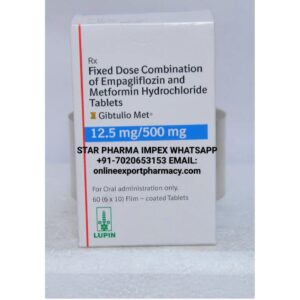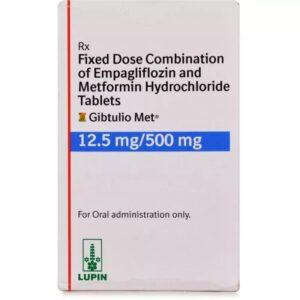METFORMIN + EMPAGLIFOZIN
Metformin: Metformin is a drug commonly used to treat type 2 diabetes. It belongs to a class of medications called biguanides. Metformin helps to control blood sugar levels by reducing the amount of glucose produced by the liver and improving the sensitivity of the body’s cells to insulin.
This drug is typically taken orally and can be prescribed alone or in combination with other antidiabetic medications. It is not used to treat type 1 diabetes.
The dose of metformin varies depending on the individual’s needs and response, but it is usually started at a low dose and gradually increased. The usual maintenance dose for most individuals is 500 mg to 2000 mg per day, divided into two or three doses.
Some common side effects of metformin include gastrointestinal symptoms like nausea, diarrhea, and abdominal discomfort. These side effects usually fade away as the body adjusts to the medication. In rare cases, metformin can cause a serious side effect called lactic acidosis, which is a buildup of lactic acid in the blood. Symptoms of lactic acidosis include weakness, dizziness, difficulty breathing, and slow heart rate. It is important to contact a healthcare professional if any of these symptoms occur.
Other less common side effects of metformin may include metallic taste in the mouth, vitamin B12 deficiency, and skin reactions such as rash or itching. It is important to discuss any concerns or side effects with a healthcare professional.
Overall, metformin is an effective and commonly prescribed medication for the management of type 2 diabetes. However, it is not suitable for everyone, so it is essential to consult with a healthcare professional to determine if metformin is the right treatment option for an individual’s specific needs.
Empaglifozin: Empagliflozin is an oral medication used to treat type 2 diabetes mellitus. It belongs to a class of drugs called sodium-glucose co-transporter 2 (SGLT2) inhibitors. Empagliflozin works by inhibiting SGLT2, a protein responsible for reabsorbing glucose in the kidneys. By blocking SGLT2, empagliflozin allows excess glucose to be excreted in the urine, reducing blood glucose levels.
The recommended starting dose of empagliflozin is 10 mg taken orally once daily in the morning, with or without food. The dose can be increased to 25 mg daily if further glycemic control is needed.
Some common side effects of empagliflozin include urinary tract infections, genital yeast infections in both males and females, increased urination, thirst, and volume depletion-related events like dizziness, low blood pressure, and dehydration. Other possible side effects may include hypoglycemia when used in combination with insulin or sulfonylureas, increased cholesterol levels, and hypersensitivity reactions.
It is important to note that empagliflozin should not be used in patients with type 1 diabetes or diabetic ketoacidosis. It is also contraindicated in patients with severe renal impairment, end-stage renal disease, or on dialysis. Other contraindications include severe hepatic impairment, known hypersensitivity to empagliflozin, and pregnancy.
Before starting empagliflozin, it is essential to consult with a healthcare professional who can determine if it is suitable for the patient’s individual needs and medical history.


